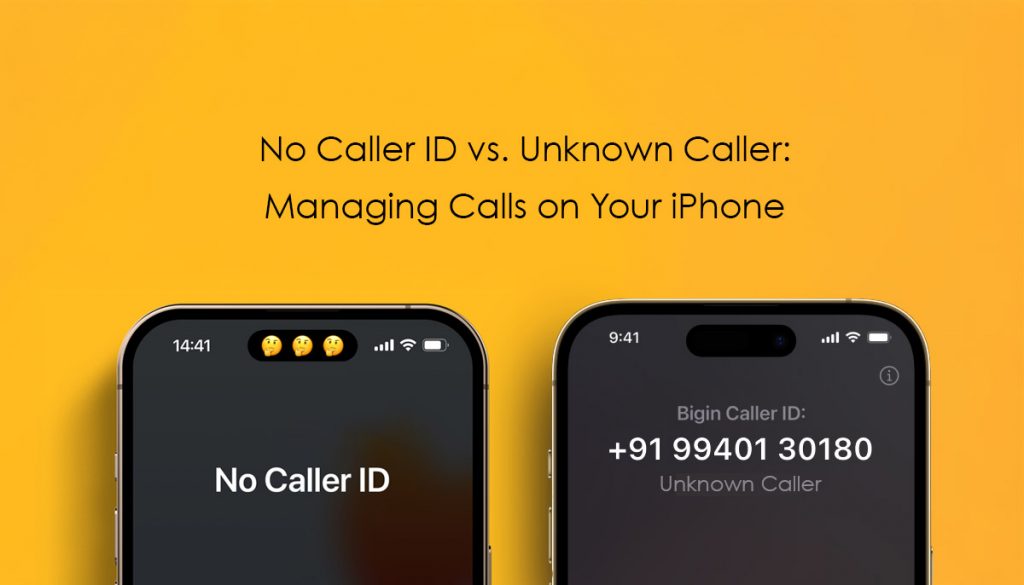You might have wondered what these terms mean if you’ve ever received a call labeled as “No Caller ID” or “Unknown Caller” on your iPhone. Both indicate that the caller’s identity isn’t immediately clear, but they happen for different reasons.
A Pew Research Center study found that 80% of Americans ignore calls from unknown numbers. Knowing the difference between “No Caller ID” and “Unknown Caller” helps you manage calls better and avoid unnecessary interruptions.
What Does No Caller ID Mean on iPhone?
“No Caller ID” means the caller has actively hidden their phone number. This happens when the caller uses a setting or feature to block their number from appearing on your screen. In these cases, your iPhone cannot identify the number because it has been deliberately masked.
There are several reasons why a caller might hide their number:
- The caller might not want to reveal their phone number for privacy reasons.
- Salespeople or scammers often hide their numbers to prevent you from blocking them, making it common in telemarketing or spam calls.
- Professionals or organizations may choose not to share their direct line to maintain anonymity or for privacy concerns.
The caller activates a feature like Caller ID Blocking to create this label. This can be done by dialing a specific code, such as *67 in the U.S., before entering the number they want to call. Your iPhone shows “No Caller ID” instead of the number when you receive the call.
What Does Unknown Caller Mean on iPhone?
An “Unknown Caller” is different. This label appears when the caller’s number is visible but isn’t saved in your contacts. Unlike “No Caller ID,” where the number is hidden, your phone sees the number but doesn’t recognize it.
Here are common reasons you might see this label:
- The caller might be using a number you haven’t saved, making it appear as an unfamiliar number.
- Calls from other countries may show up as “Unknown Caller” if the number isn’t properly formatted, which is common with international calls.
- Carrier issues can sometimes prevent the delivery of caller information, causing the call to appear as “Unknown.”
Key Differences Between No Caller ID and Unknown Caller
To clarify the distinctions further, here’s a comparison table summarizing the differences between No Caller ID and Unknown Caller:
Caller Intent
With “No Caller ID,” the caller deliberately hides their number, while “Unknown Caller” occurs when the network fails to identify the caller.
Reason for Display
“No Caller ID” often results from privacy orbusiness practices, whereas “Unknown Caller” typically stems from technical issues or international calls.
Legitimacy
Calls with “No Caller ID” can be legitimate but are often suspicious, while “Unknown Caller” may also be legitimate but is uncertain.
Tracking Ability
“No Caller ID” calls are difficult to trace, while “Unknown Caller” numbers can potentially be traced if the technical issues are resolved.
How to Handle No Caller ID Calls on iPhone
Receiving a call labeled as “No Caller ID” can feel intrusive, especially if it’s frequent. Here’s how to manage these calls:
1. Enable Silence Unknown Callers
iPhones running iOS 13 or later have a feature called Silence Unknown Callers. It automatically silences calls from unknown or hidden numbers. To enable it:
- Go to Settings > Phone.
- Toggle on Silence Unknown Callers.
2. Use Call-Blocking Apps
Third-party apps like Truecaller or Hiya can help identify and block calls from hidden numbers.
3. Contact Your Carrier
Some carriers offer tools to block all calls with hidden Caller IDs. Check with your carrier for options.
4. Avoid Answering Suspicious Calls
If you’re not expecting a call and see “No Caller ID,” let it go to voicemail. Scammers often use this label to mask their identity.
How to Handle Unknown Callers on iPhone
For “Unknown Caller” calls, your approach might differ since the number is visible:
1. Verify the Caller
If you’re expecting a call from an unfamiliar number, answer cautiously. Verify the identity of the caller before sharing any information.
2. Save Legitimate Contacts
Once you identify a genuine caller, save their number to avoid seeing “Unknown Caller” next time.
3. Use Reverse Lookup Tools
Apps or online tools can help you identify callers using their phone numbers.
Why Understanding No Caller ID and Unknown Caller Matters
Knowing the difference between “No Caller ID” and “Unknown Caller” helps you handle these calls effectively.
- Scammers often hide their Caller ID to trick you into answering. Recognizing this label can help you avoid potential fraud and protect your privacy.
- “Unknown Caller” often represents legitimate calls from unfamiliar contacts, allowing you to manage expectations and decide whether to answer.
- Features like Silence Unknown Callers are designed to reduce interruptions but work differently for each label, helping you use your iPhone features effectively.
Frequently Asked Questions
Can I Identify a No Caller ID Call?
It’s hard to identify a No Caller ID call directly, but you can try dialing *69 right after the call to see the last number that called you. Apps like Truecaller might also help reveal more details about hidden numbers.
Does No Caller ID Mean Someone Is in My Contacts?
No, it doesn’t. A No Caller ID call doesn’t mean the caller is saved in your contacts; it just means they’ve chosen to hide their number.
Is It Possible to Trace a No Caller ID Call?
Tracing a No Caller ID call is tough because the number is hidden on purpose. If you think it’s fraud, report it to the authorities—they might be able to trace it.
Caller Labels Are More Than Just a Feature
The labels “No Caller ID” and “Unknown Caller” aren’t just technical details—they help you stay cautious in a world of scams and privacy concerns. By understanding the difference, you can protect your personal information, avoid unwanted calls, and take control of how you handle communication. This knowledge turns a basic phone feature into a tool for safer and smarter calling.
